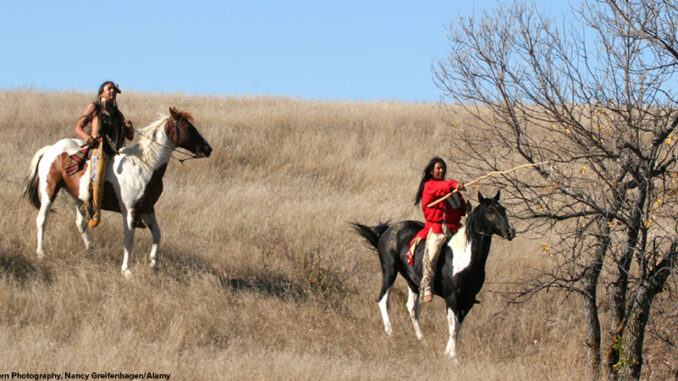
November is National Native American Heritage Month: a time to recognize and honor the cultures, contributions, and history of Native American and Alaska Native communities. In honor of Native American Heritage Month (or NNAHM), btw takes a closer look at an ongoing debate in South Dakota: requiring public schools to teach Native American history and culture.
The Essential Understandings
Currently, public schools in South Dakota are only required to teach four areas of curriculum: math, science, social studies, and English-language arts/reading. But earlier in 2025, Republican state Senator Tamara Grove, proposed requiring a fifth area of curriculum: the Oceti Sakowin Essential Understandings. (Oceti Sakowin refers to the Lakota, Dakota, and Nakota people.) Sentor Grove is a Native American who lives on the Lower Brule Reservation,

The Essential Understandings are a set of seven standards addressing Native American history, culture, beliefs and values, challenges, and contributions. For example, the Essential Understandings require students to:
- identify reservation boundaries and the stewardship of natural resources;
- understand the importance of songs and storytelling;
- recognize differing tribal cultures and languages;
- honor the role of kinship in Native American communities;
- understand history from the Oceti Sakowin perspective;
- describe the historical relationship between tribal communities and the U.S. government; and
- recognize the importance of self-determination for Native communities.
Support from the Native American Community
The Essential Understandings were created by a group of educators and tribal elders. They were adopted seven years ago by the South Dakota Board of Education Standards. Currently, the Essential Understandings are optional in South Dakota public schools.
In 2023, the state Department of Education surveyed public school teachers and found that about 62 percent of them were already using the standards. This was a big jump from 2021, when only 45 percent of public school teachers used them. However, the survey cannot be considered an accurate measure. It was a voluntary survey and only 125 of the state’s 149 school districts responded, with a total of only 385 individual teachers.
Opposition to the Idea
Leading opposition to this year’s bill was Joe Graves, South Dakota’s state secretary of education. He says that the bill isn’t necessary because parts of it are already incorporated into the state’s social studies curriculum. He also says that requiring it would overburden teachers by leaving them with less time to teach other things.
Outcome
Similar bills requiring the teaching of the standards have failed in South Dakota in the past. But Senate Bill 196 gave supporters hope in February when it passed out of the Senate Education Committee by a unanimous vote of 7-0. However, an amended version of the bill failed on the Senate floor a week later by a vote of 7-28. Instead, Governor Larry Rhoden signed a separate bill requiring all certified teachers in the state to take a course in South Dakota Indian Studies.
